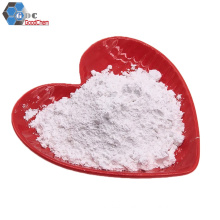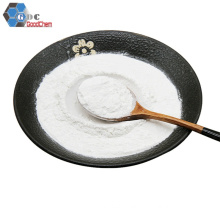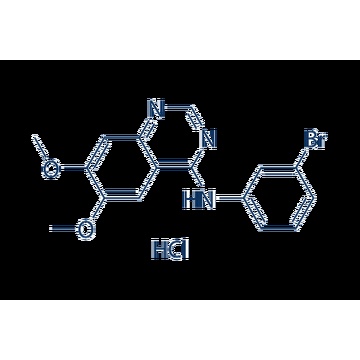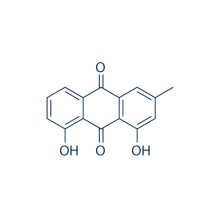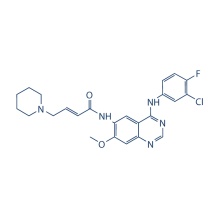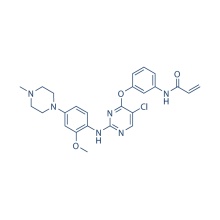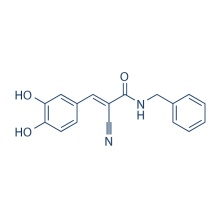.cp_wz tabla {borde superior: 1px sólido #ccc; borde izquierdo: 1px sólido #ccc; } .cp_wz table td {borde derecho: 1px sólido #ccc; borde inferior: 1px sólido #ccc; padding: 5px 0px 0px 5px;} .cp_wz table th {border-right: 1px solid #ccc; border-bottom: 1px solid #ccc; relleno: 5px 0px 0px 5px;} \ n Peso molecular: \ n 396.67 PD153035 es un inhibidor potente y específico de EGFR con Ki e IC50 de 5.2 pM y 29 pM; Se observó poco efecto contra PGDFR, FGFR, CSF-1, InsR y Src. \ n Actividad biológica PD 153035 muestra un efecto inhibidor potente y selectivo sobre la fosforilación de tirosina inducida con EGF con IC50 de 15 nM y 14 nM en fibroblasto Swiss 3T3 y A- 431 células de carcinoma epidermoide humano, respectivamente. PD153035 muestra efectos inhibidores del crecimiento en cultivos de líneas celulares de cáncer humano que sobreexpresan el receptor EGF, incluidas las células A431, Difi, DU145, MDA-MB-468 y ME180 con IC50 de 0,22 μM, 0,3 μM, 0,4 μM, 0,68 μM y 0,95 μM, respectivamente . PD153035 induce una inhibición del crecimiento dependiente de la dosis en las células del carcinoma nasofaríngeo (NPC), incluidas las líneas celulares NPC-TW01, NPC-TW04 y HONE1 con IC50 de 12,9 μM, 9,8 μM y 18,6 μM, respectivamente. Un estudio reciente muestra que PD153035 suprime la expresión de COX-2 inducida por el péptido 2-furoil-LIGRLO-NH (2) (2fLI) que activa PAR (2) en células de cáncer de colon Caco-2. En tumores epidermoides humanos A431 desarrollados como xenoinjertos en ratones desnudos inmunodeficientes, PD153035 a 80 mg / kg inhibe la actividad tirosina quinasa del receptor de EGF. PD153035 mejora la tolerancia a la glucosa, la sensibilidad a la insulina y la señalización y reduce la inflamación subclínica en ratones alimentados con HFD. El pretratamiento de los inhibidores de EGFR a las 24 horas mejora significativamente el efecto citotóxico de la doxorrubicina, el paclitaxel, el cisplatino y el 5-fluororuacilo en las células NPCTW04. Protocolo (solo como referencia) Ensayo de quinasa: [1]
|
Inhibition of EGF receptor tyrosine kinase
|
Enzyme reactions are performed in a total volume of 0.1 mL containing 25 mM Hepes (pH 7.4), 5 mM MgCl2, 2 mM MnCl2, 50 μM sodium vanadate, 0.5 to 1.0 ng of enzyme (which also contains enough EGF to make the final concentrations 2 μg/mL), 10 μM ATP containing 1 μCi of [32P]ATP, varying concentrations of PD153035, and 200 μM of a substrate peptide based on a portion of phospholipase C-γl having the sequence Lys-His-Lys-Lys-Leu-Ala-Glu-Gly-Ser-Ala-Tyr472-Glu-Glu-Val. The reaction is initiated by the addition of ATP. After 10 minutes at room temperature, the reaction is terminated by addition of 2 mL of 75 mM phosphoric acid, and the solution is passed through a 2.5-cm phosphocellulose filter disk that binds the peptide. The filter is washed five times with 75 mM phosphoric acid and placed in a vial with 5 mL of scintillation fluid. The uninhibited control activity produces approximately 100,000 cpm.
|
Ensayo celular: [2]
|
Cell lines
|
A431, Difi, DU145, MDA-MB-468 and ME180
|
|
Concentrations
|
0-3 μM
|
|
Incubation Time
|
72 hours
|
|
Method
|
Cells are seeded in sixwell plates. The next day, cells are changed to medium containing 0.5% FBS for 18 hours, and then PD153035 is added at various concentrations to the cultures. After 72 hours of treatment, cells are washed once with PBS, harvested with 0.1% human trypsin-l mM EDTA in PBS, and counted with a Coulter counter. The CMK cells grow in suspension and, therefore, do not require trypsinization.
|
Estudio con animales: [5]
|
Animal Models
|
A431 cells are injected into the outbred nude mice.
|
|
Formulation
|
PD153035 is dissolved in water.
|
|
Dosages
|
≤80 mg/kg
|
|
Administration
|
Administered via i.p.
|
|
Solubility
|
30% propylene glycol, 5% Tween 80, 65% D5W,
30 mg/mL
|
|
* Please note that Selleck tests the solubility of all compounds in-house, and the actual solubility may differ slightly from published values. This is normal and is due to slight batch-to-batch variations.
|
Conversión de diferentes modelos de animales basados en BSA (valor basado en datos del Borrador de Directrices de la FDA)
|
Species
|
Baboon
|
Dog
|
Monkey
|
Rabbit
|
Guinea pig
|
Rat
|
Hamster
|
Mouse
|
|
Weight (kg)
|
12
|
10
|
3
|
1.8
|
0.4
|
0.15
|
0.08
|
0.02
|
|
Body Surface Area (m2)
|
0.6
|
0.5
|
0.24
|
0.15
|
0.05
|
0.025
|
0.02
|
0.007
|
|
Km factor
|
20
|
20
|
12
|
12
|
8
|
6
|
5
|
3
|
|
Animal A (mg/kg) = Animal B (mg/kg) multiplied by
|
Animal B Km
|
|
Animal A Km
|
Por ejemplo, para modificar la dosis de resveratrol utilizada para un ratón (22,4 mg / kg) a una dosis basada en el BSA para una rata, multiplique 22,4 mg / kg por el factor Km para un ratón y luego divida por el factor Km para una rata. Este cálculo da como resultado una dosis equivalente para ratas de resveratrol de 11,2 mg / kg.
|
Rat dose (mg/kg) = mouse dose (22.4 mg/kg) ×
|
mouse Km(3)
|
= 11.2 mg/kg
|
|
rat Km(6)
|
Información química
|
Molecular Weight (MW)
|
396.67
|
|
Formula
|
C16H14BrN3O2.HCl
|
|
CAS No.
|
183322-45-4
|
|
Storage
|
3 years -20℃Powder
|
|
6 months-80℃in solvent (DMSO, water, etc.)
|
|
Synonyms
|
SU-5271 (AG1517) HCl ,ZM 252868 HCl
|
|
Solubility (25°C) *
|
In vitro
|
DMSO
|
0.5 mg/mL
(1.26 mM)
|
|
Water
|
<1 mg/mL
(
|
|
Ethanol
|
<1 mg/mL
(
|
|
In vivo
|
30% propylene glycol, 5% Tween 80, 65% D5W
|
30 mg/mL
|
* <1 mg/ml means slightly soluble or insoluble.
* Please note that Selleck tests the solubility of all compounds in-house, and the actual solubility may differ slightly from published values. This is normal and is due to slight batch-to-batch variations.
|
|
Chemical Name
|
N-(3-bromophenyl)-6,7-dimethoxyquinazolin-4-amine hydrochloride
|
Calculadora de molaridad Calculadora de dilución Calculadora de peso molecular
Grupos de Producto : Proteína tirosina quinasa > Inhibidor de EGFR

